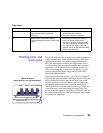68
Chapter 4: Managing memory
Flash memory
Your printer comes with 4MB of standard flash memory. If
you frequently download fonts, macros, forms, or symbol
sets to your printer, you may want to use flash memory
storage, rather than RAM. Resources stored in flash mem-
ory are not lost when the printer power is turned off or the
printer is reset.
Hard disk
If you have a large number of permanent resources you’d
like to download to your printer, you may want to install a
hard disk option. The hard disk works much like flash
memory, but has a larger storage capacity for downloaded
resources. You can also use the hard disk for job buffering,
collating large jobs, and gathering job statistics.
For instructions on installing a hard disk, refer to the
printer Setup Guide.
Job buffering
You can partition a portion of the hard disk for job buffer-
ing. In some cases, spooling jobs to a disk may decrease
the time required for the printer to accept the print job
data from the application. The job also remains stored in
the disk until the entire job prints. Since disk memory acts
as permanent storage, that means your jobs remain secure
in the event of a power failure.
You can enable or disable job buffering for each of the
available printer ports (parallel, serial, fax, network,
LocalTalk, and infrared) from the printer operator panel
menus or from MarkVision. Use the Job Buffer Size menu
item in the Setup Menu to set the percentage of the disk
you want to use for job buffering.
Collating jobs
If you are collating a large job and the printer memory is
not sufficient, the printer automatically uses storage area
available on an installed hard disk to finish collating the
job. See page 22 for more information about collation.


















